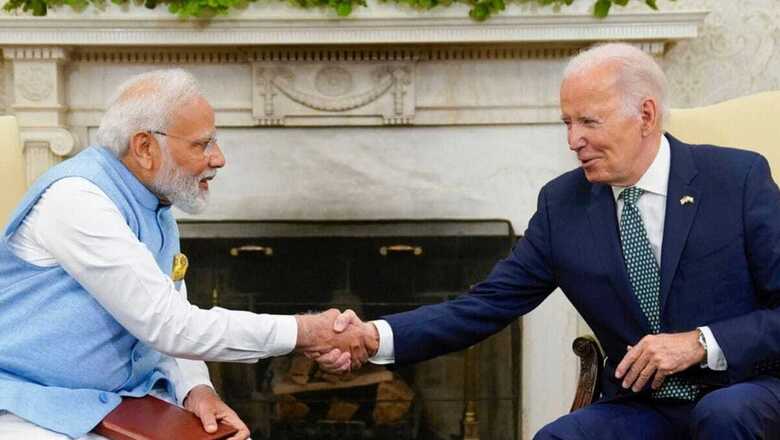
views
Foreign affairs experts have pointed out that, “India- US relations are at their peak.” The G-20 Summit hosted by India holds a testament to this. Pictures and videos of US President Joe Biden with Indian Prime Minister Narendra Modi are viral on social media and have become one of the many highlights of the meeting.
Both India and US define their relations as a “strategic partnership”. US Department of State mentions that “The U.S.-India strategic partnership is founded on shared values including a commitment to democracy and upholding the rules-based international system. The United States and India have shared interests in promoting global security, stability, and economic prosperity through trade, investment, and connectivity.”
India in its foreign relations brief states that “The emphasis placed by the Government in India on development and good governance has created an opportunity to reinvigorate bilateral ties and enhance cooperation under
the motto — “Chalein Saath Saath: Forward Together We Go”, and “SanjhaPrayas, Sab ka Vikas” (Shared Effort, Progress for All) was adopted during the first two summits of Prime Minister Modi and President Obama in September 2014 and January 2015 respectively.”
TRACING INDIA- US RELATION HISTORY
When India was struggling to get independence, the then US President Harry S Truman fervently backed its quest. After independence, India and the US found each other on different pages in various geopolitical concerns. History narrates that during the Cold War era, the US wanted India to join its camp while India was not reluctant owing to its Non-Alignment Movement.
When the US sided with Pakistan during the war of 1971 and even on the Jammu and Kashmir issue at the UN Security Council (UNSC), India paid a high price for it. The US disregarded India’s plea for food aid, especially wheat when widespread famines struck the country. The PL-480 statute passed in 2006, was used by the US to entrap other countries into its camp. It was in 2006 when the historic Indo-US nuclear pact was signed and solidified their alliance.
Since then, India and US relations have been on an upswing with regular engagements across departments and the introduction of various dialogue architecture.
India in its foreign relation brief states that, today the India-U.S. bilateral cooperation is “broad-based and multi-sectoral”, covering trade and investment, defence and security, education, science and technology, cyber security, high-technology, civil nuclear energy, space technology and applications, clean energy, environment, agriculture, and health. Vibrant people-to-people interaction and support across the political spectrum in both countries nurture the bilateral relationship claims the Indian brief.
DEFENCE CORPORATIONS
With the signing of the “New Framework for India-US Defense Relations” in 2005 and the ensuing intensification of defense trade, joint exercises, personnel exchanges, collaboration and cooperation in maritime security and counter-piracy, as well as exchanges between each of the three services, the defense relationship has emerged as a key pillar of the India-U.S. strategic partnership. In June 2015, the Defence Framework Agreement was amended and extended for an additional ten years. The Indian brief mentions that India- US aggregate worth of defence acquisition from the US side has crossed over US$ 13 billion.
ECONOMIC RELATIONS
India-US bilateral trade in goods and services increased from $104 billion in 2014 to $114 billion in 2016. The two-way merchandise trade stood at $66.7 billion. Of this, India’s exports of goods to the US were valued at $46 billion and India’s imports of goods from the US were valued at $21.7 billion.
India-US trade in services stood at $47.2 billion. Of this, India’s exports of services to the US were valued at $26.8 billion and India’s imports of services from the US were
valued at $20.3 billion states Indian Brief. On the other hand, in 2021, U.S.-India bilateral trade in goods and services reached a record $157 billion claims the report from the US Department of State. The nearly 2,00,000 Indian students in the United States contribute $7.7 billion annually to the U.S. economy.
INTERNATIONAL COOPERATION
At global institutions like the United Nations, G-20, ASEAN Regional Forum, International Monetary Fund, World Bank, and World Trade Organization, India and the United States work closely together. The United States supported a restructured UN Security Council that includes India as a permanent member and welcomed India’s two-year membership in 2021. The United States joined the International Solar Alliance, which has its headquarters in India, in 2021.
WAY FORWARD
Both parties are beginning to understand that India may be a reliable friend of the US rather than a conventional ally and vice versa. The relationship would be mature if neither party allowed their differences to cloud their view of a bigger picture where there are common national interests. In the twenty-first century, the relationship between India and the US is still crucial for determining the global order.
Explore other career options with us: Career in Sound Designing, Sound Engineering | Sustainability Professional | Yoga & Naturopathy | Software Testing | Medical Coding | Cloud Developer & Cloud Architect | 3D Technology | Garment Technologist |AI & Robotics |Fashion Designing |Supply Chain Finance |Animal Welfare | Public Relations | Gaming Industry | Functional Nutrition |




















Comments
0 comment